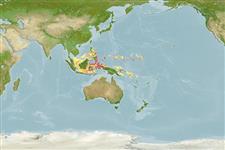>
Gobiiformes (Gobies) >
Gobiidae (Gobies) > Gobiinae
Etymology: Eviota: No etymology given, suggested by Christopher Scharpt: from Latin 'eu' for 'true' and 'iota' for anything very small, in combination 'truly very small' referring to it as being the smallest vertebrate at the time it has benn described by Jenkins (thus, making the suggestion by Scharpt plausible.; pinocchioi: Named after Carlo Collodi’s fictional character Pinocchio; referring to the exceptionally long anterior tubular nares in this species..
Environment: milieu / climate zone / depth range / distribution range
Ecología
marino asociado a arrecife; rango de profundidad 14 - 73 m (Ref. 92345). Tropical
Western Pacific: Palau and Indonesia.
Tamaño / Peso / Age
Maturity: Lm ? range ? - ? cm
Max length : 1.7 cm SL macho / no sexado; (Ref. 92345)
Short description
Claves de identificación | Morfología | Morfometría
Espinas dorsales (total) : 7; Radios blandos dorsales (total) : 9; Espinas anales: 1; Radios blandos anales: 8; Vértebra: 25. This species is distinguished from its congeners by the following set of characters: cephalic sensory-pore system always lacking POP and IT pores, PITO and AITO pores fused 50% of time; dorsal/anal fin-ray formula 8/8; unbranched pectoral-fin rays; 4th pelvic-fin ray bifurcated with each branch about 50% of the total length of the ray; unbranched 5th pelvic-fin ray 6.5-15.3 (11.0%) of 4th; in males, dorsal-fin spines are filamentous, very long tubular anterior nares, length almost equal to pupil diameter, reaching well anterior to the upper lip, and black; in life body translucent and crossed by six narrow red bands and when preserved, devoid of obvious dark marks on body (Ref. 92345).
Found in vertical drop-off with caves and sandy and slope with some Halimeda (Ref. 92345).
Life cycle and mating behavior
Maturities | Reproducción | Spawnings | Egg(s) | Fecundities | Larva
Greenfield, D.W. and R. Winterbottom, 2012. Two new dwarfgobies from the Southwestern Pacific Ocean (Teleostei: Gobiidae: Eviota). Zootaxa 3572:33-42. (Ref. 92345)
IUCN Red List Status (Ref. 130435)
Threat to humans
Harmless
Human uses
Herramientas
Special reports
Download XML
Fuentes de Internet
Estimates based on models
Preferred temperature (Ref.
123201): 27.2 - 29, mean 28.7 °C (based on 20 cells).
Phylogenetic diversity index (Ref.
82804): PD
50 = 0.5000 [Uniqueness, from 0.5 = low to 2.0 = high].
Bayesian length-weight: a=0.01023 (0.00477 - 0.02194), b=3.02 (2.84 - 3.20), in cm total length, based on LWR estimates for this (Sub)family-body shape (Ref.
93245).
Nivel trófico (Ref.
69278): 3.0 ±0.3 se; based on size and trophs of closest relatives
Fishing Vulnerability (Ref.
59153): Low vulnerability (10 of 100).
